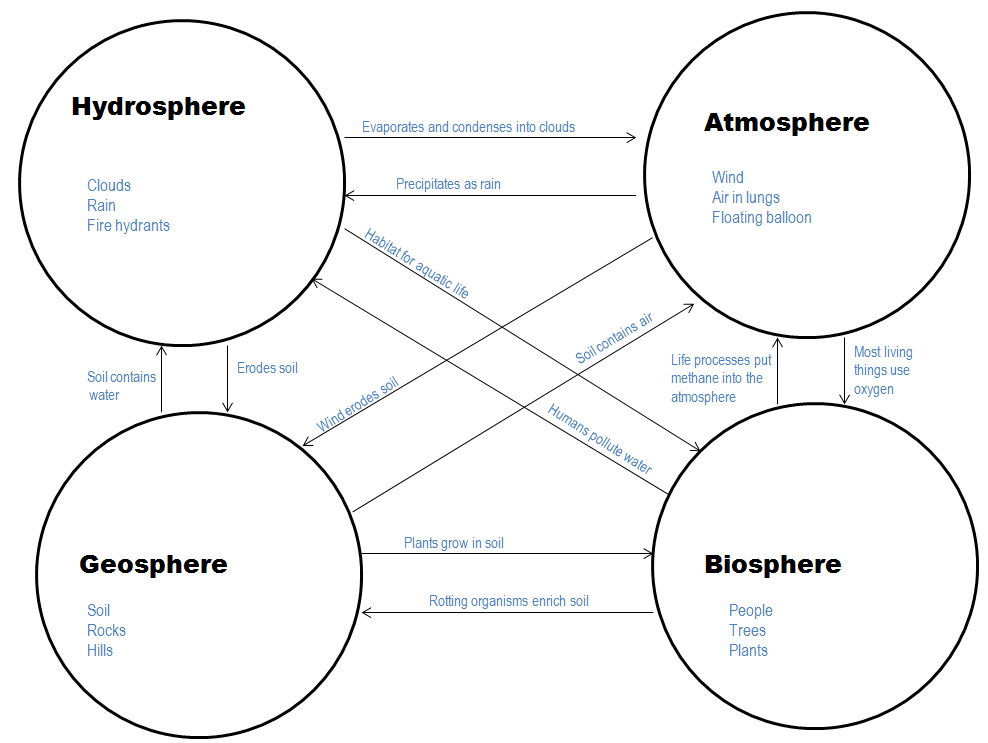Geoscience Women in STEM

Lesson 3: Carbon Cycle
As a biogeochemist, Dr. Jahren has devoted much of her life to studying the carbon cycle, the processes by which carbon is exchanged among our planet's natural spheres. Students in this lesson explore the carbon cycle, not only in the abstract, but in the world they find outside.
Journeying through the carbon cycle, students can practice systems thinking skills as they move from one simulated reservoir to another. A visit to their school campus provides new opportunities for students to make place-based observations and categorize them into the four spheres — geosphere, hydrosphere, atmosphere, and biosphere. Developing a visual model helps students consider interactions among the components of spheres and build systems thinking skills. As students wrap up the lesson they return to their personal timelines and explore how their thinking has changed with regard to their talents and STEM.
Connections to the Next Generation Science Standards (NGSS)
- MS-ESS2-1 - Develop a model to describe the cycling of Earth's materials and the flow of energy that drives this process. (NGSS DCI Arrangement, 2017, p. 69)
- HS-ESS2-6 - Develop a quantitative model to describe the cycling of carbon among the hydrosphere, atmosphere, geosphere, and biosphere. (NGSS DCI Arrangement, 2017, p. 98)
To learn more about NGSS Disciplinary Core Ideas click here
Activity: Exploring the Carbon Cycle — A Learning Game
To learn more about the NGSS and Models click here.
In this NOAA role play activity, students map out the pathways carbon takes on its journey through the carbon cycle. Students can compare the carbon cycle before and after the industrial revolution as a way of thinking about connections between climate science and the carbon cycle.
The practice of developing models is integral to the NGSS. Students should use their journey in the carbon cycle game to develop a carbon cycle model. Students can sketch models on paper or use a tool such as a Google Drawing or Lucidchart.
Developing and Using Models: Students develop, use and revise models to describe, test, and predict more abstract phenomena and design systems. This includes developing and using a model to describe unobservable mechanisms.
Activity: Evidence of the Carbon Cycle on Your Campus
Students can test the carbon cycle model they have drawn by going outside, making observations, and collecting evidence for the carbon cycle. The evidence students collect outdoors can be organized on an Earth systems diagram like the one below.

Using the carbon cycle model that students sketched and the systems model they created with evidence from outside, students can modify their model to make it more complete. Students should discuss components of the carbon cycle that they don't see as well as components that are more evident. They can then draw their revised mode on another Earth systems diagram.
Activity: Wrapping-Up Lesson 3
Revisiting their personal timelines from Lesson 1, students can consider how their new understanding of science and scientists has affected their thinking. How do they now think about the way their lives might be affected by science and other STEM fields? How might students affect science and other STEM fields? As scientists? As science literate citizens and members of other professions?
The activities on this website are intended to promote the idea that all people are invited to join in creative endeavors of science. Individuals of all backgrounds, ages, and abilities can be encouraged to engage with the geosciences, whether as a geoscience professional, as a hobbyist, or through civic engagement. Because each person has a role to play in the areas that geoscientists study — including Earth's resources, natural hazards, and understanding the wonder of our environment — geoscience truly is for everyone.
For more information and resources related to the theme "Geoscience Is for Everyone" and geoscience education in general, visit the Earth Science Week website.
